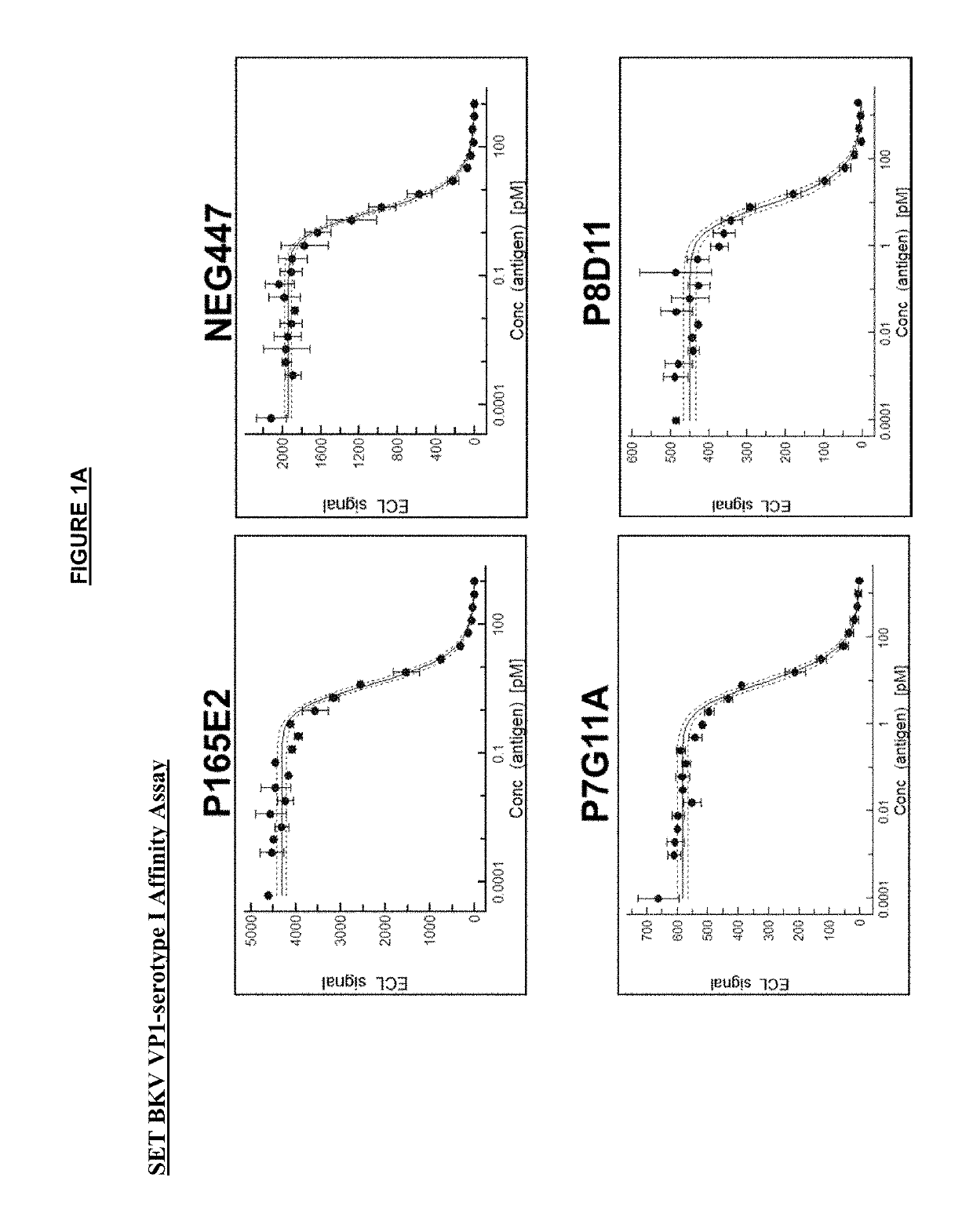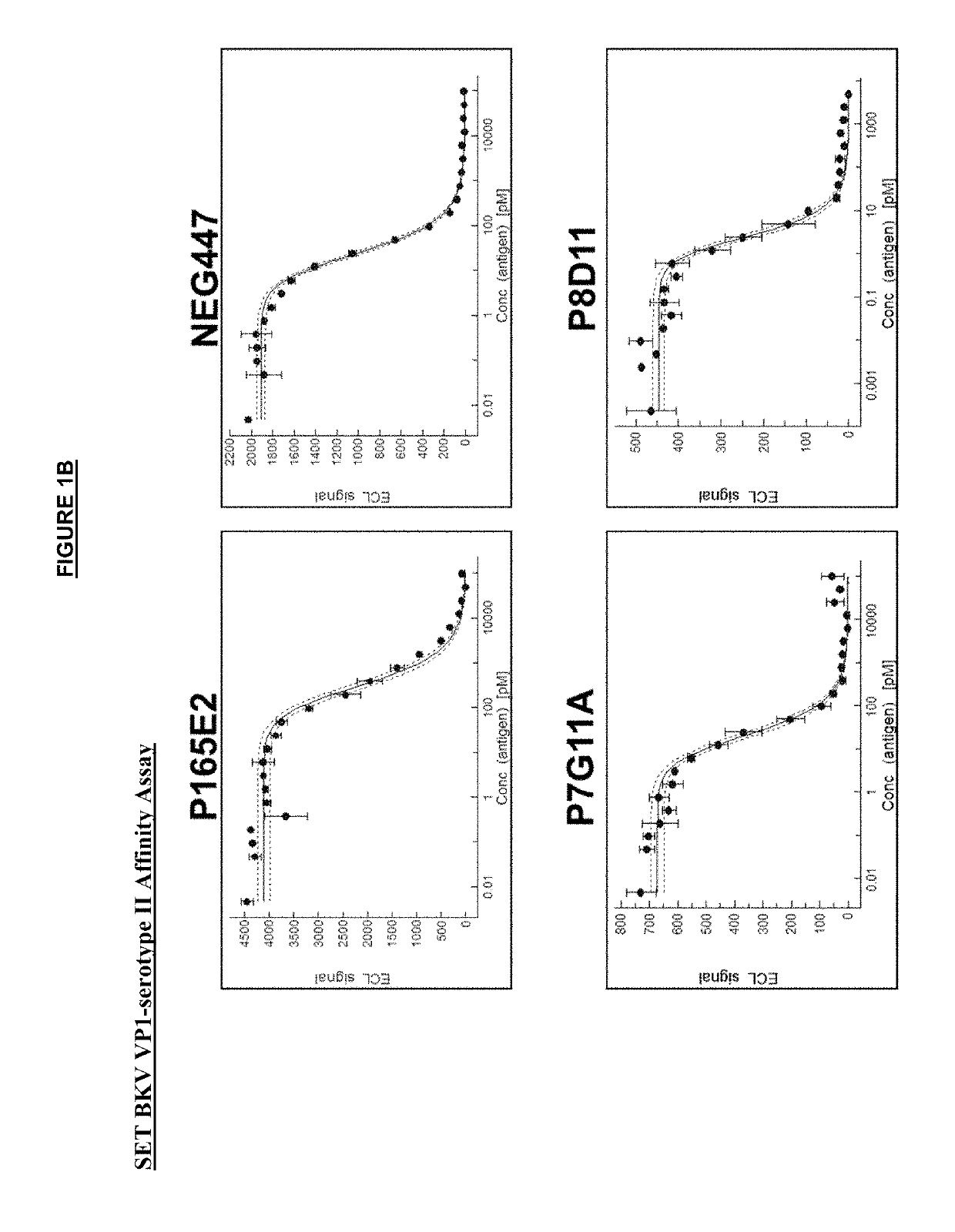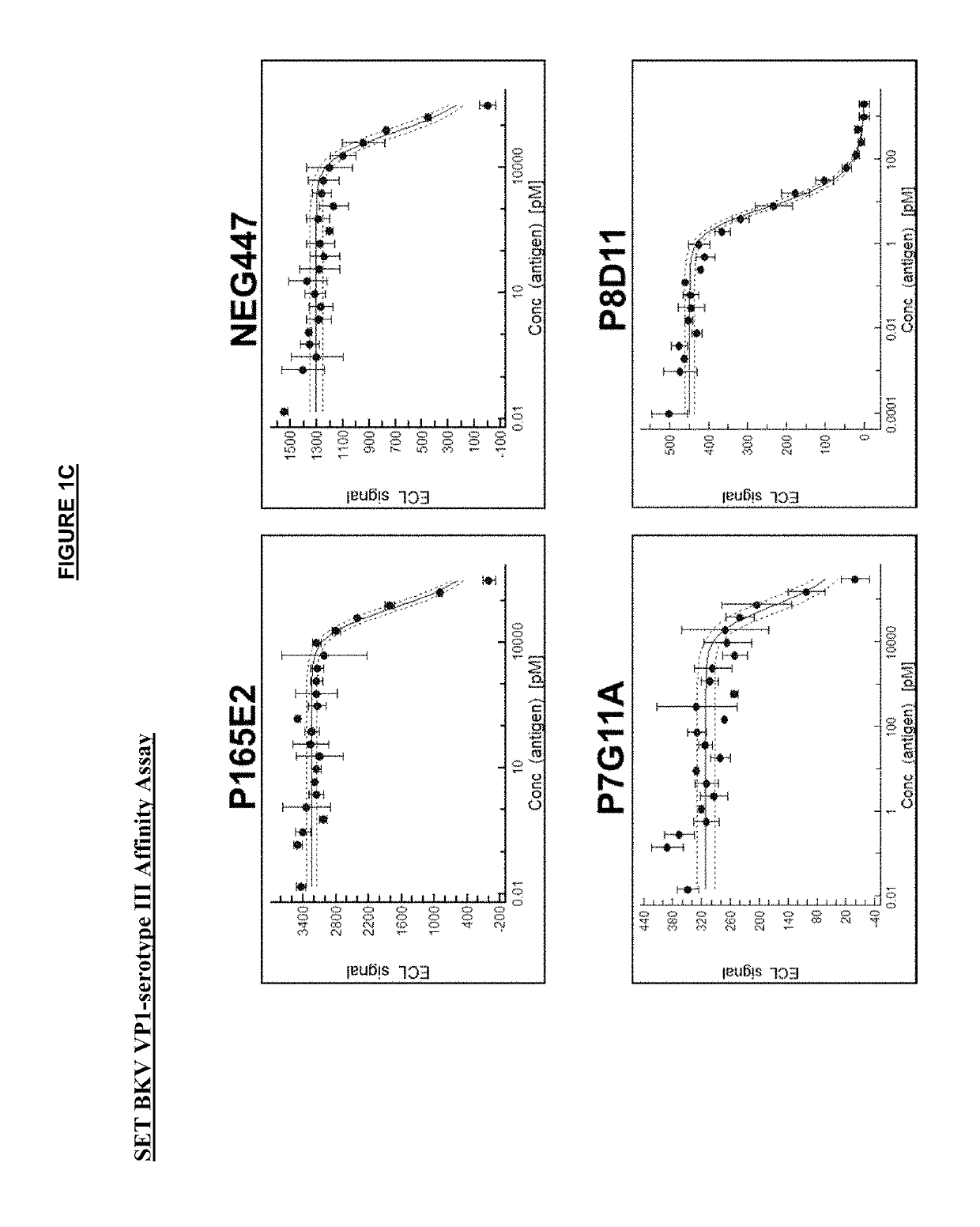Polyomavirus neutralizing antibodies
a technology of polyomavirus and neutralizing antibodies, which is applied in the field of antivp1 antibodies and antibody fragments, can solve the problems of increased risk of acute rejection, uncontrolled bkv replication, and bkv-associated nephropathy
- Summary
- Abstract
- Description
- Claims
- Application Information
AI Technical Summary
Benefits of technology
Problems solved by technology
Method used
Image
Examples
example 1
n of Anti-VP1 Antibodies
[0308]B cells expressing anti-VP1 antibodies were lysed and the VH (heavy) and VL (light) chains were sequenced by RT-PCR and analyzed to identify critical post translational modification (PTM) sites. Plasmids of the VH and VL chains were then transfected in a CHO mammalian cell line in an IgG1 back bone vector for expression of the full IgG1 antibodies.
[0309]Methods for generation of monoclonal antibodies using hybridoma technology are known in the art (Antibody Methods and Protocols, Methods in Molecular Biology vol. 901, 2012, Chapter 7: 117). Briefly, female Balb / c mice were immunized with VLPs from BKV serotype I, serotype IV, and JCV (either individually or in combination) using various prime-boost strategies, doses of immunogen, and adjuvants (including but not limited to Freund's adjuvant and MF59 adjuvant). Supernatant of successfully fused (growing) hybridomas were screened for the presence of anti-VP1 antibodies by ELISA, then for functional activi...
example 2
Maturation of Anti-VP1 Antibodies
[0312]The anti-VP1 antibodies were affinity matured in yeast by error-prone PCR or CDR-directed mutagenesis. VP1 proteins from each of the four serotypes of BKV (as shown in Table 4) were used as the antigen in up to three rounds of selection by FACS analysis. VH (heavy) and / or VL (light) chains with enhanced binding affinity to VP1 by FACS analysis were then cloned into mammalian IgG1 backbone expression vectors and transfected in a CHO mammalian cell line for expression of the full IgG1 antibodies.
[0313]
TABLE 4NameVP1 proteinSEQ ID NOSerotype 1,FSLKLSAENDFSSDSPERKMLPCYSTARIPLP(SEQ IDamino acidsNLNEDLTCGNLLMWEAVTVQTEVIGITSMLNO: 496)66-145NLHAGSQKVHEHGGGKPISerotype II,YSLKLTAENAFDSDSPDKKMLPCYSTARIPL(SEQ IDamino acidsPNLNEDLTCGNLLMWEAVTVKTEVIGITSMNO: 497)66-145LNLHAGSQKVHENGGGKPVSerotype III,YSQHLSAENAFDSDSPDKKMLPCYSTARIPL(SEQ IDamino acidsPNLNEDLTCGNLLMWEAVTVKTEVIGITSMNO: 498)66-145LNLHAGSQKVHENGGGKPVSerotype IV,YSLRLTAETAFDSDSPDRKMLPCYSTARIPLP(SEQ I...
example 3
and Virus-Like Particle (VLP) Generation
[0314]Genomic clones of BKV serotype I were obtained from ATCC (pBR322-BKV MM, cat #45026; pBR322-BKV Dunlop, cat #45025). Infectious genomic clones of chimeric viruses for serotype II, III and IV were generated using the cloning strategy described previously (Broekema et al, Virology 2010 407:368-373). Briefly, unique restriction sites (SacII, PmlI) were introduced into BKV serotype I genomes flanking the VP1-VP2-VP3 coding region using site-directed mutagenesis. The coding region for VP1 from serotype II isolate SB (GenBank Accession CAA79596.1), serotype III isolate AS (GenBank Accession AAA46882.1) and serotype IV strain ITA-4 (GenBank Accession BAF75132) were synthesized in the context of VP2 / VP3 coding region from the serotype I isolates (Genewiz, La Jolla, Calif.), such that the synthesized fragments encompassed the SacII-PmlI region to be used for swap combinations as described in Broekema et al., supra. The resulting chimeric genomic ...
PUM
| Property | Measurement | Unit |
|---|---|---|
| pharmaceutical composition | aaaaa | aaaaa |
| nucleic acid | aaaaa | aaaaa |
Abstract
Description
Claims
Application Information
 Login to View More
Login to View More - R&D
- Intellectual Property
- Life Sciences
- Materials
- Tech Scout
- Unparalleled Data Quality
- Higher Quality Content
- 60% Fewer Hallucinations
Browse by: Latest US Patents, China's latest patents, Technical Efficacy Thesaurus, Application Domain, Technology Topic, Popular Technical Reports.
© 2025 PatSnap. All rights reserved.Legal|Privacy policy|Modern Slavery Act Transparency Statement|Sitemap|About US| Contact US: help@patsnap.com



